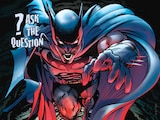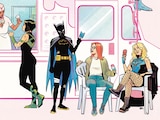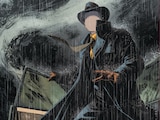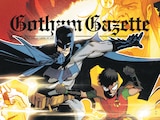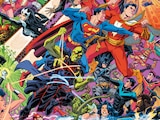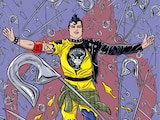What is the greatest riddle that the Riddler has ever told? “How is a raven like a writing desk?” “When is a door?” “What weighs six ounces, sits in a tree, and is pretty dangerous?” No. The greatest riddle the Riddler has ever told is: who is the Riddler? It’s something we’ve ostensibly known the answer to since his debut in 1948. But with so many disparate visions of the character, perhaps only Batman knows who Eddie Nygma (if that’s even his real name) truly is. As we prepare for a battle between two of Gotham’s most complex minds in The Batman, now is the time to examine what we know about who the Riddler really is. Because when you fight the Riddler, the best weapon to pack in your utility belt is knowledge.
Intellectual Gatekeeper

Question number one when dealing with the Riddler: why does he always leave clues to his crimes?
One thing we can safely assume about the Riddler is that for him, it’s never really been about the money. (The Batman: Arkham video game series even suggests that Nygma is already independently wealthy.) The crime isn’t even the point—they’re just the way Nygma gets people to pay attention to his brain teasers. In HBO Max’s Batman: The Audio Adventures, Riddler calls himself an “artist of crime.” His heists and schemes aren’t about personal wealth, but making a statement.
That’s true enough, to a point. But the statement in question is always the same: “I’m smarter than you are.”

For most versions of the character, the Riddler’s only goal is to prove his intellectual dominance in Gotham City over the only person he sees as his equal—the Batman. And yet, Riddler loses the challenge to his cowled opponent every single time. So why does he persist? And why, for that matter, does Batman? Wouldn’t simply appealing to the Riddler’s ego get him to leave Gotham alone?
Scott Snyder’s Batman comics provide another perspective: that it’s not even about whether Batman can solve the riddle, but the intellectual pursuit of the solution. Riddler sees himself not as Batman’s rival, but his tutor, keeping the Dark Knight always at his sharpest for the battles to come. Almost admirable, in its way, if not for the lives he puts in danger in the process.
World’s (Other) Greatest Detective

Batman: The Animated Series is an indisputably integral part of the Batman canon, often reinterpreting Batman’s opponents with sympathy and a unique depth which has changed the way they’ve been portrayed forever. Mister Freeze was given his Nora. Poison Ivy transformed from femme fatale to environmental crusader. Riddler, well…what about Riddler?
To series creators Bruce Timm and Paul Dini, Eddie was the toughest nut to crack (particularly because, as they’re both the first to admit, neither of them were very good at riddles). Their first effort resulted in a reinterpreted Riddler as a fiendish game designer with Batman as his intended player—a portrayal which would go on to inform Batman’s relationship with this Prince of Puzzles in the Arkham games. But in the 1994 episode “Riddler’s Reform,” a different riddle presents itself all together: what would the Riddler look like if he stuck to his intellectual pursuits, but abandoned crime?

The initial story shows us an Eddie Nygma who’s given himself entirely to designing mind-challenging toys akin to the Rubik’s Cube, earning him the esteem he so craved. But, without the opportunity to best Batman, it was a contentment which would not last. So, Dini presented a new approach on Riddler for his run on Detective Comics in 2006, one which would allow him to continue to match wits with Batman without resorting to crime. Rather than presenting riddles of his own, Edward Nygma would prove his superiority as the one solving crimes before Batman could.
It was a unique period which produced some of the most beloved Riddler stories to date. But as is so often the case with Batman’s rogues, it was only a matter of time before he returned to his more criminal predilections. Still, the notion of a Riddler who uses his intellect to solve crimes rather than commit them has lived on since that time, from Justice League Action to TV’s Gotham.
Relic of a Bygone Age

Okay, let’s get real here. The truth is when most people imagine the Riddler, they don’t imagine some brooding, intellectual rival to the World’s Greatest Detective. They picture a giddy little weirdo in a skintight green jumpsuit with question marks all over it, dropping clues before his heists that were either plucked from a children’s riddle book or devised from complete doggerel nonsense. It’s Frank Gorshin’s Riddler in the ’60s Batman TV show, who as the pilot’s villain set the tone for the series as a whole. It’s Jim Carrey’s Riddler, in Joel Schumacher’s campy opus Batman Forever. More than that, it’s Bill Finger and Dick Sprang’s Riddler, created in 1948 as one of many colorful opponents for Batman to face.
So, why does Riddler so often feel like a children’s story character? Well, because he is one. And that’s okay! Comics, and their characters, should be fun! Part of what makes Batman special as a whole is that it has the freedom to get as dark or as colorful as it’s inclined, and never betray the malleable source material.

It’s to this version of the Riddler that Neil Gaiman wrote his paean on the character for his Secret Origins special, “When is a Door.” In this story, written years before his reinvention in The Animated Series, Riddler stands alone as the last bastion of the era of goofy Batman villains—a memento of when the battle between crime and justice in Gotham City used to be fun before it all turned so serious in the 1980s.
Fortunately for all, time has proven there’s room for both versions of Batman in the cultural landscape, and every shade imaginable in between. Even as The Batman is about to present what may be the darkest Riddler yet, the Gorshins, Astins and Carreys out there will never be too difficult to find.
Portrait of a Serial Killer

There’s another way to see the Riddler. It’s the one that’s just now finding its way into the public eye, born from a new wave of fascination with true crime and the criminals who commit them. Consider this: what kind of person leaves intentional clues for authorities to find? What sort of mind delights in publicly eluding his captors, for anonymous prestige and infamy, seeking attention just as much, if not more so, than the thrill of the crime itself? Hundreds of documentary specials, nonfiction books, and podcasts all point to the same real world archetypical bogeyman—the serial killer.
A criminal who ritualistically kills person after person is terrifying enough to capture anyone’s imagination, but when one leaves intentional notes and evidence to their intent, as they are sometimes wont to do, it becomes a phenomenon that we as a culture are helpless to turn away from. This is the germ of an idea which inspired Geoff Johns and Gary Frank’s Riddler in the Batman: Earth One graphic novels…and is very much the one we’ll see on screen as played by Paul Dano in The Batman. Will this new, darker take on the character change the cultural perception of the Riddler as we know it? That’s a riddle we’ll have to wait to be solved.
The Batman, directed by Matt Reeves and starring Robert Pattinson, Zoe Kravitz and Paul Dano as the Riddler, is in theaters on March 4. Be sure to check out our official movie page for all the latest news, articles and videos.
Alex Jaffe is the author of our monthly "Ask the Question" column and writes about TV, movies, comics and superhero history for DCComics.com. Follow him on Twitter at @AlexJaffe and find him in the DC Community as HubCityQuestion.




